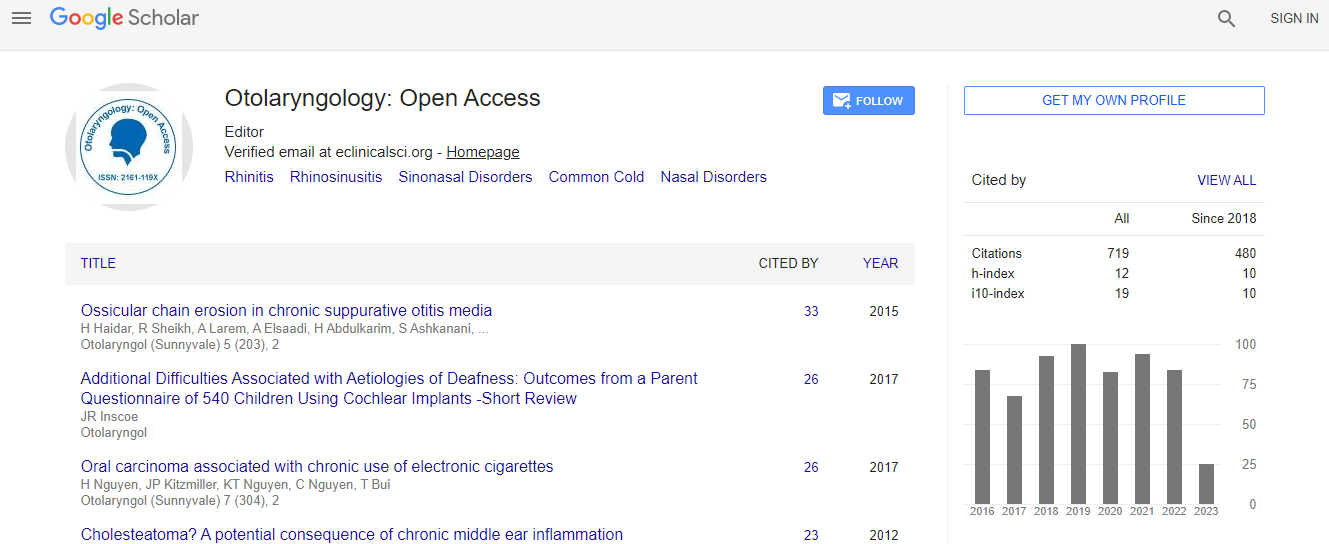Our Group organises 3000+ Global Conferenceseries Events every year across USA, Europe & Asia with support from 1000 more scientific Societies and Publishes 700+ Open Access Journals which contains over 50000 eminent personalities, reputed scientists as editorial board members.
Open Access Journals gaining more Readers and Citations
700 Journals and 15,000,000 Readers Each Journal is getting 25,000+ Readers
Google Scholar citation report
Citations : 925
Otolaryngology: Open Access received 925 citations as per Google Scholar report
Otolaryngology: Open Access peer review process verified at publons
Indexed In
- Index Copernicus
- Google Scholar
- Sherpa Romeo
- Open J Gate
- Genamics JournalSeek
- RefSeek
- Hamdard University
- EBSCO A-Z
- OCLC- WorldCat
- Publons
- Geneva Foundation for Medical Education and Research
- ICMJE
Useful Links
Recommended Journals
Related Subjects
Share This Page
Simultaneous palatoplasty and premaxillary setback in children with bilateral complete cleft lip and palate with protruding premaxilla
Global Summit and Medicare Expo on Head & Neck Surgery
Bijoy Krishna Das
Care Hospital, Bangladesh
Posters-Accepted Abstracts: Otolaryngol (Sunnyvale)
Abstract
The bilateral cleft lip and nasal deformity has a wide degree of variability with regards to the severity of the cleft. Achieving good results after primary repair in children with complete bilateral cleft lip and palate with protruding premaxilla is a difficult task. Multiple surgeries can overcome these problems but due to financial constraints and the distance travel, these patients prefer to come for fewer procedures with maximum benefits. Simultaneous palatal closure and premaxillary setback in children with bilateral complete cleft of the lip and palate with severely protruding premaxilla can overcome the problem with minimum surgeries. A prospective study was carried out in 20 patients. After osteotomy and resection of a segment of vomer with nasal septal cartilage, the premaxilla was immobilized in all patients using the simple technique of Kirschner wire fixation; an additional gingivoperioplasty was performed in a few patients. Good exposure of the vomer made premaxillary setback easy without compromising the blood supply to it. Palatal closure was achieved with two flap techniques. Simultaneous lip adhesions were also done. Proper positioning of the premaxilla was achieved in all patients. After 4-6 months of the primary palate closure, lip repair was done. There were no complications like loss of the premaxilla or vascular compromise. One patient had a postalveolar tiny fistula which healed spontaneously. Follow up period ranged from 6 months to 2 years. In managing the children with bilateral cleft lip and palate and a protruding premaxilla, this technique is well indicated. It is advantageous in achieving good results with fewer procedures and thus reduces the total expenditure and the length of the patient�s hospital stay.Biography
Email: info@drbijoydas.com

 Spanish
Spanish  Chinese
Chinese  Russian
Russian  German
German  French
French  Japanese
Japanese  Portuguese
Portuguese  Hindi
Hindi 
